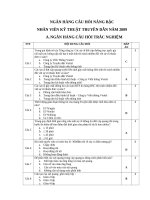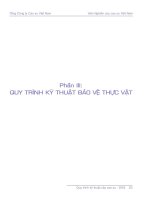KỸ THUẬT TRUYỀN DẪN VIBA SỐ - CHƯƠNG 1 ppt
Bạn đang xem bản rút gọn của tài liệu. Xem và tải ngay bản đầy đủ của tài liệu tại đây (1.02 MB, 20 trang )
KỸ THUẬT TRUYỀN DẪN VIBA SỐ
Nguyễn Huy Hùng
Mobile: 0914908070
Email:
2005-01-21
Lecture 1
2
Mục đích môn học
Nghiên cứu các thành phần cơ bản trong quá trình phân tích và thiết
kế hệ thống viba số :
Các kỹ thuật chủ yếu
Formatting and source coding
Modulation (Baseband and bandpass signaling)
Channel coding
Equalization
Synchronization
Phân tích tuyến truyền dẫn vô tuyến
Hệ thống truyền dẫn viba số
2005-01-21
Lecture 1
3
Tài liệu
Course text book:
“Digital communications” by John G. Proakis
Additional recommended books:
“Communication systems engineering”, by John G. Proakis
and Masoud Salehi, Prentice Hall, 2002, 2
nd
edition, ISBN:
0-13-095007-6
“Digital communications: Fundamentals and Applications”
by Bernard Sklar,Prentice Hall, 2001,ISBN: 0-13-084788-7
“Communication Systems, Analysis and design”, by
H.P.E.Stern and S. A. Mahmoud, Prentice Hall, 2004, ISBN:
0-13-121929-4
2005-01-21
Lecture 1
4
Today, we are going to talk about:
What are the features of a Digital
communication system (DCS)?
Why “digital” instead of “analog”?
What do we need to know before taking off
toward designing a DCS?
Classification of signals
Random process
Autocorrelation
Power and energy spectral densities
Noise in communication systems
Signal transmission through linear systems
Bandwidth of signal
2005-01-21
Lecture 1
5
Block diagram of a digital
communication system
SOURCE
Info.
Transmitter
Transmitted
signal
Received
signal
Receiver
Received
info.
Noise
Channel
Source User
Formatter
Source
encoder
Channel
encoder
Modulator
Formatter
Source
decoder
Channel
decoder
Demodulator
Transmitter
Receiver
2005-01-21
Lecture 1
6
Digital communication system …
Important features of a DCS:
Transmitter sends a waveform from a finite set of
possible waveforms during a limited time
Channel distorts, attenuates the transmitted signal
and adds noise to it.
Receiver decides which waveform was transmitted
from the noisy received signal
Probability of erroneous decision is an important
measure for the system performance
2005-01-21
Lecture 1
7
Digital versus analog
Advantages of digital communications:
Regenerator receiver
Different kinds of digital signal are treated
identically.
Data
Voice
Media
Propagation distance
Original
pulse
Regenerated
pulse
A bit is a bit!
2005-01-21
Lecture 1
8
Phân loại tín hiệu
Tín hiệu xác định và tín hiệu ngẫu nhiên
Deterministic signal: Có thể xác định giá trị của tín
hiệu tại bất kỳ thời điểm nào.
Random signal: Không thể xác định được giá trị
của tín hiệu trước khi nó xãy ra
Thermal noise in electronic circuits due to the random
movement of electrons
Reflection of radio waves from different layers of
ionosphere
2005-01-21
Lecture 1
9
Phân loại tín hiệu…
Periodic and non-periodic signals
Analog and discrete signals
A discrete signal
Analog signals
A non-periodic signal
A periodic signal
2005-01-21
Lecture 1
10
Phân loại tín hiệu
Tín hiệu năng lượng và tín hiệu công suất
A signal is an energy signal if, and only if, it has
nonzero but finite energy for all time:
A signal is a power signal if, and only if, it has
finite but nonzero power for all time:
General rule: Periodic and random signals are power
signals. Signals that are both deterministic and non-
periodic are energy signals.
2005-01-21
Lecture 1
11
Random process
A random process is a collection of time functions, or
signals, corresponding to various outcomes of a
random experiment. For each outcome, there exists
a deterministic function, which is called a sample
function or a realization.
Sample functions
or realizations
(deterministic
function)
Random
variables
time (t)
Real number
2005-01-21
Lecture 1
12
Random process …
Strictly stationary: If none of the statistics of the random process
are affected by a shift in the time origin.
Wide sense stationary (WSS): If the mean and autocorrelation
function do not change with a shift in the origin time.
Cyclostationary: If the mean and autocorrelation function are
periodic in time.
Ergodic process: A random process is ergodic in mean and
autocorrelation, if
and
, respectively.
2005-01-21
Lecture 1
13
Autocorrelation
Autocorrelation of an energy signal
Autocorrelation of a power signal
For a periodic signal:
Autocorrelation of a random signal
For a WSS process:
2005-01-21
Lecture 1
14
Spectral density
Energy signals:
Energy spectral density (ESD):
Power signals:
Power spectral density (PSD):
Random process:
Power spectral density (PSD):
2005-01-21
Lecture 1
15
Properties of an autocorrelation
function
For real-valued (and WSS in case of random signals):
1. Autocorrelation and spectral density form a
Fourier transform pair.
2. Autocorrelation is symmetric around zero.
3. Its maximum value occurs at the origin.
4. Its value at the origin is equal to the average
power or energy.
2005-01-21
Lecture 1
16
Noise in communication systems
Thermal noise is described by a zero-mean Gaussian
random process, n(t).
Its PSD is flat, hence, it is called white noise.
[w/Hz]
Probability density function
Power spectral
density
Autocorrelation
function
2005-01-21
Lecture 1
17
Signal transmission through
linear systems
Deterministic signals:
Random signals:
Ideal distortionless transmission:
All the frequency components of the signal not only arrive
with an identical time delay, but also are amplified or
attenuated equally.
Input
Output
Linear system
2005-01-21
Lecture 1
18
Signal transmission … - cont’d
Ideal filters:
Realizable filters:
RC filters Butterworth filter
High-pass
Low-pass
Band-pass
Non-causal!
2005-01-21
Lecture 1
19
Bandwidth of signal
Baseband versus bandpass:
Bandwidth dilemma:
Bandlimited signals are not realizable!
Realizable signals have infinite bandwidth!
Baseband
signal
Bandpass
signal
Local oscillator
2005-01-21
Lecture 1
20
Bandwidth of signal – cont’d
Different definition of bandwidth:
a) Half-power bandwidth
b) Noise equivalent bandwidth
c) Null-to-null bandwidth
d) Fractional power containment bandwidth
e) Bounded power spectral density
f) Absolute bandwidth
(a)
(b)
(c)
(d)
(e)50dB









